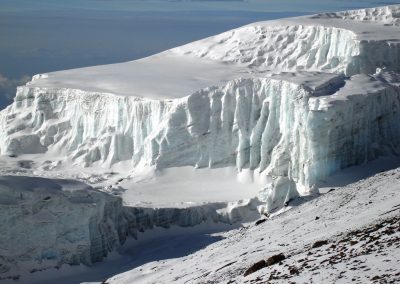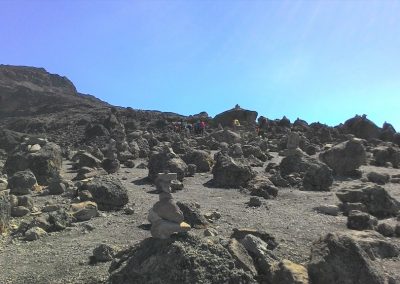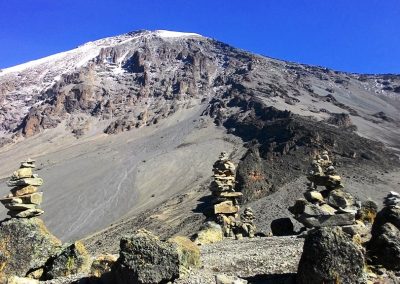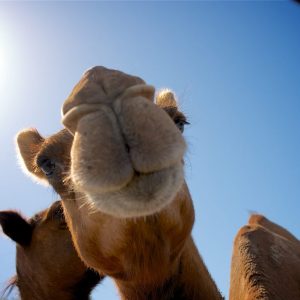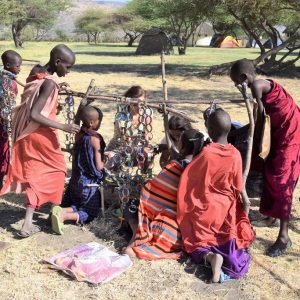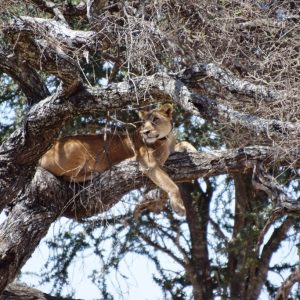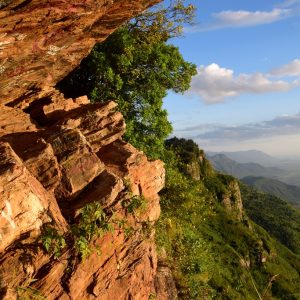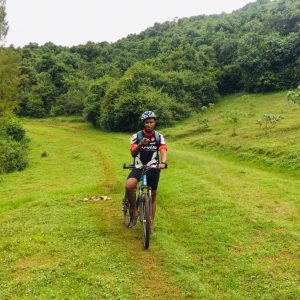8 Days Kilimanjaro Lemosho Route (7 days possible)
- The most untouched, quietest and longest route
- Acclimatize at the Northern Circuit and increase your chance of reaching the summit
- 95% Summit Success Rate
- Enjoy the view of the Kenyan highlands and the northern glaciers
Tour FAQs
- Overview
- Itinerary
- Circuit / Region
- Included Services
- Excluded Services
- Options
- Rates
- Best Time To Travel
- Packing Tips
- Notes
The Lemosho Route is regarded as one of the prettiest routes on Kilimanjaro. We begin trekking in the thick, fertile rain-forest until we reach the wildflowers and shrubs of the heath ecosystem. Approaching from the west, we cross one of the most beautiful areas on Kilimanjaro, the vast Shira Plateau, before traversing the mountain along the southern circuit. As you cross the Shira plateau on the Lemosho route from east to west, you get an impressive view of the Kibo summit. The Lemosho route is for those with previous backpacking experience. Because of the start and the extra days at low altitude, the Lemosho Route is probably the best trek for acclimatization. In addition, the Lemosho Route connects to the Machame Route after a few days, which increases the success rate even more.
Short Overview
Day 1: Londorossi Gate to Big Tree Camp
1.830 m/6,000 ft to 2.780m/9,120 ft
Duration: 3 - 4 h
Day 2: Big Tree Camp to Shira Camp 1
2.780m/9,120 ft to 3.500 m/11,500 ft
Duration: 5 - 6 h
Day 3: Shira Camp 1 via Shira Camp 2 to Moir Hut
3.500 m/11,500 ft to 4.200 m/13,800 ft
Duration: 5 - 7 h
Day 4: Moir Hut via Lava Tower to Barranco Camp
4.200m/13,800 ft via 4650m/15,200 ft to 4.000m/13,100 ft
Duration: 5 - 6 h
Day 5: Barranco Camp to Karanga Camp
4.000 m/13,100 ft to 4.040 m/13,255 ft
Duration: 4 - 5 h
Day 6: Karanga Camp to Barafu Camp
4.040 m/13,255 ft to 4.700 m/15,400 ft
Duration: 4 - 5 h
Day 7: Barafu Camp via Stella Point to Uhuru Peak and descent via Mweka route to Mweka Camp
4.700 m/15,400 ft to 5895 m/19,341 ft to (3100 m/10,170 ft
Duration 5 - 7 h up/5 - 6 h down
Day 8: Mweka Camp to Mweka Gate
3.100m/10,065 ft to 1.640 m/5,380 ft
Duration: 3 - 4 h
Detailed Itinarary
- Day 1: Arrival and transfer to Arusha
Welcome! Karibu sana! – Today you will be picked up at Kilimanjaro International Airport or Arusha Domestic Airport and then taken to your accommodation in Arusha. The drive from Kilimanjaro Airport to Arusha takes approximately one hour.Meal plan: Dinner (meals are depending of your arrival time)
Possible Accommodation: Mambo Arusha Hostel (budget), Tulia Boutique Hotel & Spa (mid-range) or Mvuli Hotel (mid-range)
- Day 2: Londorossi Gate - Big Tree Camp
After completing the necessary registration formalities at Londorossi National Park Gate, we drive another 15 km on a bumpy forest road. We often have our lunch at the roadhead before starting to walk. Finally, we walk on a small path through the unspoilt beautiful and lush forest on a moderate slope up to the Big Tree Camp today's goal. Since there are still many elephants and buffaloes in this region, we may also be accompanied by an armed ranger on the route. Maybe you can spot colobus monkeys jumping around in the treetops. Upon arrival, the tents are already set up and hot tea awaits us. - Day 3: Big Tree Camp – Shira Camp 1
After breakfast we will soon leave the forest behind and the vegetation changes into the moorland zone with giant heather and huge lobelia plants. We walk through lush hills and several streams before we reach Shira Ridge. Then we gently descend to the Shira 1 camp. On the way we take a first look over the plateau to the Kibo. - Day 4: Shira Camp 1 – Shira Camp 2 – Moir Hut
For better acclimatization, we explore the Shira plateau for the whole day. It's a gentle eastward walk toward Kibo's glacier summit over the plateau that leads to Shira 2 camp. We continue our hike through the alpine zone to Moir Hut. A little used campsite at the foot of the Lent Hills. There are a variety of hiking trails around the Lent Hills that make this an excellent acclimatization opportunity. Shira is one of the highest plateaus on earth and there are excellent views. - Day 5: Moir Hut – via Lava Tower - Barranco Camp
This day is very important for acclimatization. We follow the principle of "walk high - sleep low". We walk on lava ridges beneath the glaciers of the Western Breach. After lunch near the Lava Tower junction we descend to the bottom of the Great Barranco Valley sheltered by towering cliffs and with extensive views of the plains far below near our campsite at Barranco Valley. On the descent we pass huge lobelia and meter-high senecia and have an impressive view of the Kibo glacier. - Day 6: Barranco Camp - Karanga Camp
Once again “Pole Pole”. A steep climb to the Barranco wall brings us to a path that leads past the southeast flank of the Kibo with a wonderful view of the southern ice fields. The terrain changes to scree, with pockets of vegetation in sheltered hollows. From there it is only a short distance to our camp at Karanga, the last water point on the way to the summit. - Day 7: Karanga Camp - Barafu Camp
Today a short stage leads us to the Barafu Camp. We follow an easy path on compacted scree to reach the Barafu campsite for lunch. There is a short acclimatization walk to the plateau at the bottom of the South-East valley (4,800 m/15,700 ft). The remainder of the day is spent resting in preparation for the final ascent. - Day 8: Barafu Camp via Stella Point to the summit Uhuru Peak and descent via Mweka route to Mweka forest camp
We will start our ascent by torchlight at about 1 a.m. The steep climb over loose volcanic scree has some well-graded zigzags and a slow but steady pace will take us to Stella Point (5752 m/18871 ft) in about five or six hours. We will rest there for a short time to enjoy the sunrise over Mawenzi. Faster hikers may see the sunrise from Uhuru Peak, which is a 1 - 2 h climb. On the way to the summit we pass close to the spectacular glaciers and ice cliffs that still occupy most of the summit area. Finally arrived at Uhuru Peak we reached the highest point of Mount Kilimanjaro and the African continent. The descent to Barafu is surprisingly fast, and after some refreshment, we continue the descend to Mweka forest camp. - Day 9: Mweka forest camp to Mweka Gate
A sustained descent through lovely forest with lush undergrowth takes us to Mweka National Park gate where you will get your summit certificates. From there we continue another hour to Mweka Village where the car is already waiting for us to bring you back to your accommodation in Arusha for relax. It is also possible to end the tour in a hotel in Moshi.
Your luggage may be taken from your hotel in Arusha to Moshi, the final destination of the Lemosho route. It depends on your additional program.
- Transport from and to your hotel/residence or Airport/seaport
- First night in Arusha
- private English-speaking Professional mountain guides
- Guides, Porters, cook salaries
- All park fees
- Rescue fees
- All meals while on the mountain incl. filtered Water, tea & coffee
- Government taxes, VAT and All relating service charges
- First Aid Kit & summit Oxygen
- Hot Water for washing
- Sleeping tent
- Mess tent
- Table and chairs
- Sleeping form mattress
- Emergency evacuation by Flying doctor
- International/national flights and visa fees
- Tips for guides and support staff
- Sleeping bag, mat and personal items for the hike (please have a look at our packing list). Almost all equipment is available to rent from our team in Tanzania if required.
- Bath towels
- Private portable toilet and privacy tent
- Personal expenses (airport taxes, Internet, soft and alcoholic drinks, snacks, laundry etc.)
- Government-imposed increase in taxes and/or park entrance fees
- Anything else not mentioned in the inclusions
- This route can be done in 7 days but it is advised to take an extra day for acclimatization
- On request other tour languages possible
- Additional accommodation after the tour can be arranged for an extra cost
- Extension of the tour or an additional program is possible or have a look at our other offers.
- Between January and March the temperatures are mild, the weather in the morning and afternoon is nice and the visibility of the mountain is particularly good
- In June and July the sky is clear and the nights are cold
- August, September and October are the warmest months to climb Kilimanjaro
- Rainy season: Late March to mid-May and November and December. There is snow in the higher elevations
Please follow the list below to ensure your comfort. You will have a better vacation if you are prepared.
But please note that this list is not exhaustive!
Almost all equipment is available to rent from our team in Tanzania if required. Please talk to us in advance for further planning.
The climb to the summit of Kilimanjaro leads through four climatic zones. Therefore, the weather can range from warm and tropical at the base of the mountain to freezing on the summit and the temperatures can range from + 20 ° C down to -15 ° C.
Cotton should be avoided as it is hydrophilic, which means it absorbs moisture and blocks breathability.
Since June 1, 2019, Tanzania has been banned from using single-use plastic bags. If you want to separate items in your bag, please use re-usable "packing cubes". Please also note that disposable plastic bottles are not permitted on Kilimanjaro.
Please note that your large backpack can weigh a maximum of 20 kg. This is the maximum permissible weight that a porter can carry. This weight limit is checked at the hotel pickup.
To carry your most important belongings with you, a 20 - 40 l daypack is best. You should pack your backpack very carefully and not carry too much with you, because at altitude you need all the strength for your ascent.
Basic Equipment
- Daypack 30 – 40 L (for your personal belongings, you need to carry it yourself) + rain cover
- Duffle bag or backpack (60 – 80 L / maximum weight 20 kg/carried by the porter) + rain cover
- Sleeping bag (possible to hire from our team in Tanzania)
- 1x mat/sleeping pad – to protect from hard and cold underground (possible to hire from our team in Tanzania)
- Trekking poles
- Water bladder/bottles for 3 liters of water (please remember disposable plastic bottles are not permitted)
CLOTHES
Head
- Warm hat
- Sun hat
- Scarf
- Sunglasses with high UV protection
- Headlamp (for summit night and toilet) with extra batteries
Hands & Feet
- 1 x light gloves
- 1 x winter gloves (summit day)
- Waterproof Hiking boots (they should fit well, with lots of room for the toes, and are well worn in before starting the trek)
- Training shoes (for the camp)
- Outer socks, liner socks and one pair of thermal socks for summit day
- Gaiters (protection against the ingress of rubble and moisture / not particularly necessary)
- Micro-spikes (possible to hire from our team in Tanzania)
Upper body and legs
- Fleece or softshell jacket
- Hard shell outer jacket (for protection against rain and wind)
- Poncho (recommended if climbing during raining season April/May and November
- Fleece pullover
- Long and short sleeve hiking shirts
- Functional sports underwear
- Thermal or fleece leggings
- Light or medium trekking pants
- Hard shell pants (waterproof/windproof)
POSSIBLE CONTENT of a PHARMACEUTICAL TRAVEL KIT
- Plasters & blister plasters, tapes, bands, cotton, alcohol
- Medicine against diarrhea, nausea, headache, stomachache, altitude sickness, Malaria
- Painkillers
- Personal medication
- Nasal spray
- Antiseptic ointment
- Electrolytes (to avoid dehydration in case of high fluid loss)
- Contact lenses cleaner
- Insect repellent
MISCELLANEOUS
- Sunscreen with High SPF and lip protection balm
- Packing cubes (for organizing the items in the duffle bag)
- Personal snacks (e. g. cereal & energy bars, nuts, isotonic drink powder, chewable vitamin tablets with dextrose)
- Ear plugs
- Toilet bag for personal belongings like toothbrush, toothpaste, soap, wet wipes and hand sanitizer
- Towel
- Camera and spare batteries
- The two different seasons that represent the best time to Climb Kilimanjaro are January - March and June - October.
Are you ready to explore Africa?
This itinerary is an example of tours we organize.
Contact us by email, WhatsApp or phone to create your individual trip or choose one of our itineraries without obligation!
-book now-




